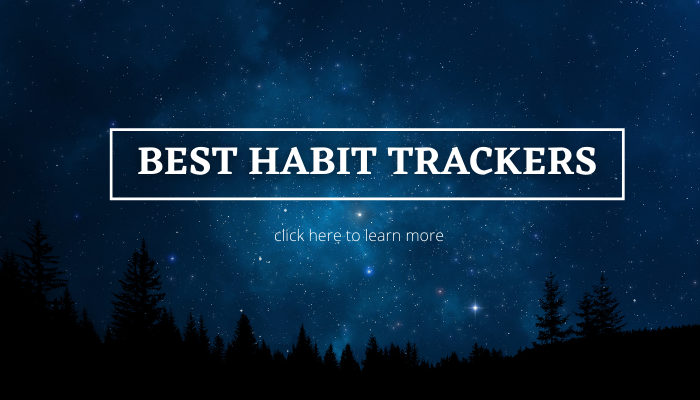Most of us understand that our lives are made up of both good and bad habits.
Regardless of whether they are good or bad, habits are developed over time so that they are often performed without active thinking.
Scientifically, this allows the brain to focus on other things without devoting so much energy to behaviors that have become rote and routine.
For example, most adults don’t have to focus on each individual step of brushing their teeth because the behavior has become habitual across time.
Thankfully, there are methods that people of any age can use to build good habits and break bad ones, including the helpful tool known as a habit planner.
Building Good Habits
Caretakers spend a good deal of time and energy helping children build good habits.
Good habits are self-reinforcing in that they often lead to positive outcomes and are therefore continued, such as saying “please” and “thank you.”
However, we learn as we grow that there are additional habits that we can develop to serve our interests as well, in terms of health and/or happiness.
One good habit to build, for example, is drinking more water throughout the day for hydration and health benefits.
This may seem like an easy habit to acquire. However, like all habits, drinking more water each day requires an interval of mindful effort, preparation, and dedication before it becomes a natural part of your daily routine.
Like any type of building, good habits must start with a strong foundation.
This means setting yourself up for success with a planned and thoughtful approach until the behavior doesn’t require much active thought.
In the case of drinking more water, you could fill bottles each night and have them ready in the refrigerator to grab at the start of each day, so they are easily accessible.
Another strategy might be to set an alarm throughout the day as a reminder to drink a glass of water.
With consistent effort and commitment, building this good habit wouldn’t take very long.
In terms of building more complex habits, such as bigger life changes, it’s helpful to structure a more formal and multi-step approach.
A habit planner can help in these cases through setting long-term goals and creating a process to help achieve them.
Breaking Bad Habits
All of us have bad habits that we wish we could break, from biting our fingernails to midnight snacking.
It may seem logical to simply decide to “stop” these habitual behaviors, but that approach is almost always ineffective and short-lived.
Instead, research indicates that habits aren’t so much “broken” through the willpower to stop as they are replaced by a different habitual behavior.
This is essential for success—to understand that whatever we characterize as a bad habit must be replaced by a different habit.
Though replacing one habit for another may seem easy or straightforward, it takes a good deal of mindfulness and dedication to accomplish.
Most of our habits are done without heavy conscious thought or attention. For example, when most people get into a car, they don’t require much concentration to buckle their seatbelt.
This action is simply habitual, and a good habit to have.
Bad habits also don’t require much concentration, which is why being mindful of when we are doing them is key to interrupting the bad habit and choosing to replace it with a better one.
If, for example, you had a habit of biting your nails while watching television and you wanted to “break” this behavior, first you would have to be mindful of it.
That means you would have to acknowledge doing the bad habit in the moment and taking action to replace it.
In the case of nail biting while watching television, you may have to replace that behavior with something else that keeps your hands away from your mouth.
This could be as simple as squeezing stress balls instead, petting your dog, or switching to a different activity.
There are many complicated “bad” habits such as smoking that require more complex solutions than mindful substitution with a different habit.
However, the approach and principles are similar.
The key is developing an awareness of performing the bad habit and immediately replacing it with a more productive and specific behavior in a consistent way until the bad habit diminishes and is eliminated altogether.

How a Habit Planner Can Help
Since most of our habits become automatic and ingrained in our brains through repetition, we don’t give them much thought.
Therefore, one of the best ways to change an established habit or build a new one is to actively put thought and planning into it.
This is how a habit planner can help. Here are some steps to take to build a habit planner and structure your success:
Determine your long-term goal and write it as a heading in your habit planner.
Putting a long-term goal into words creates an achievement that is meaningful, focused, and ultimately attainable. It’s essential to be both specific and realistic so that your goal is measurable and can therefore be rewarded.
- For example, consider this long-term goal: I want to lose weight and get in shape. Unfortunately, this goal is phrased in such a way that the goal is not measurable.
- A better way to phrase this long-term goal: I want to wake up 30 minutes earlier, Monday through Thursday, and spend that time doing a cardio workout.
This phrasing is specific, realistic, and indicates a goal that is measurable and can be rewarded.
Create short-term habitual tasks, based on your long-term goal, and write them as steps in your habit planner.
An overall habit plan for a long-term goal is an accumulation of short-term habits that are connected to and build upon each other.
Again, the individual steps should be worded in a specific and realistic way, and they should be related so that each successful completion connects to the next step.
- In continuation of the example above, two short-term habitual tasks must be established to meet the long-term goal: waking up 30 minutes earlier, Monday through Thursday, and doing a cardio workout.
- To achieve the first short-term task, it must become habit to wake up 30 minutes earlier, Monday through Thursday. To begin, this step should be phrased: Set alarm for 30 minutes earlier on Monday, Tuesday, Wednesday, and Thursday, and get out of bed. This will connect the new habit of waking up 30 minutes earlier to the habit of waking up in general. Once this successfully becomes a habitual routine, after a couple of weeks, the next step can be addressed.
- To achieve the second short-term task, it must become habit to spend the 30 extra wakeful minutes doing a cardio workout. This step should be phrased: Do cardio workout upon waking up for 30 minutes, Monday, Tuesday, Wednesday, and Thursday. This will connect the cardio workout to the established habit of waking up earlier on these days. Once this also successfully becomes a habitual routine, another habit can be introduced.
Write daily or weekly reflections in your habit planner, perform a self-assessment at set intervals, and reinforce healthy habitual behavior.
These actions will allow you to see your progress across time and help overcome any setbacks along the way.
- It’s important to use the habit planner to reflect on your successes and challenges. Writing daily or weekly reflections allows you the opportunity to record your thoughts and feelings in a private and honest manner. Some days may be easier than others and writing about it can provide insight into achievements as well as struggles.
- Decide to set intervals to perform a self-assessment. These intervals can be weekly or monthly. Self-assessment should not include self-criticism. Instead, it should be an honest look at your progress across time in creating short-term habitual tasks and how those tasks relate to your long-term goal. This allows you to make any adjustments in your habit planner if something isn’t working and reward yourself for accomplishments.
- Reinforce healthy habitual behavior. This reinforcement should be related to your long-term goal and the habits you have established, whether it is buying something small as a reward for successful intervals or writing a letter to yourself in praise of your hard work. It’s important to understand that “unhealthy” rewards may undermine and/or interrupt the habits you have worked to develop.
Habit planners can be personalized so that they are effective for each individual.
The important principles to follow are establishing a clear long-term goal, creating short-term tasks that are related to previous routines and build on each other for reaching the long-term goal, and recognizing and reinforcing successful changes in habits.
Overall, good habits take time to build, and bad habits take time to break. In addition, building good habits and breaking bad habits take effort and commitment.
A habit planner can help you structure your success and meet your long-term goals with focus and reinforcement.
You may also be interested in:
1. Fun Mindfulness Activities For Adults
2. How to Start a Manifesting Journal
3. Positive Affirmations For Mental Health




